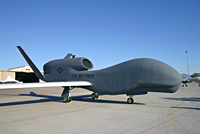Biologically-Inspired Systems
A Crowded Airspace

The proliferation of unmanned aerial vehicles (UAVs) by law enforcement, government, and military agencies has spawned a whole new field of research related to collision detection and avoidance in small form factor, low power environments. While on surveillance missions, UAVs are typically flying “under the radar” and must be able to detect other mid-air threats such as other aircrafts, birds, manmade structures, and unexpected terrain.
Putting Nature to Work
In nature, many animals such as fish and insects have the uncanny ability to avoid collisions in a three-dimensional space despite their relatively simple brains. Realizing that these abilities would translate well to UAV collision detection, the researchers at EM Photonics have been investigating systems inspired by the biological “avoidance systems” found in these animals. By utilizing our expertise in both image processing and low-power computing, we have the ideal skill set to bring these unique technologies to the airspace.
Gone Fishin’

If you’ve ever seen a school of fish swimming, you might have noticed that despite traveling in a massive swarm, the fish never seem to collide with each other. In an effort to understand this phenomenon and apply it to UAV navigation, the researchers at EM Photonics have teamed up with neuroscientists in an effort to build neural-network based collision detection algorithms. These artificial intelligence algorithms attempt to model the actual neuron activity within a fish brain during collision detection which can enable technologies that allow for a “school” of UAVs to safely fly in formation.
A Bug’s Perspective

While Hollywood has certainly helped to dramatize the truth, an insect’s eye plays a prominent role in its collision detection. Made up of dozens of small facets, an insect simultaneously sees its surroundings from multiple different angles and focal points. An insect’s brain then automatically combines these separate images to obtain a higher resolution, depth aware representation of its surroundings. To apply this idea to UAV threat detection, EM Photonics has been researching the use of plenoptic lenses and advance image processing algorithms for UAVs.

